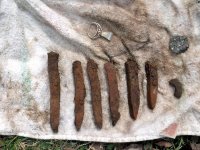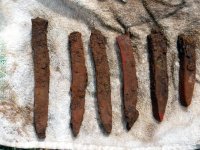desmobob
Full Member
- Apr 10, 2005
- 191
- 198
- Detector(s) used
- XP Dēus, White's DFX, Garrett Ace 250
- Primary Interest:
- All Treasure Hunting
Anyone have any ideas? They sort of look like spikes, but they're all slightly curved and the points are simple, chisel-ground on one side only (the concave side of the curve. They were all in the same hole and all slightly different lengths. The square ends look like they were mostly cut, then broken off? Hard to say...
They don't look corroded or deteriorated enough to be from the French and Indian War, but were found at the site of a battle. The stone on the top right of the first photo has a flaky, metallic look, and sounded off well but I forgot to note the number.
They don't look corroded or deteriorated enough to be from the French and Indian War, but were found at the site of a battle. The stone on the top right of the first photo has a flaky, metallic look, and sounded off well but I forgot to note the number.












